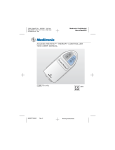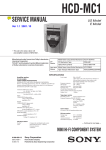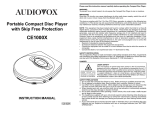Download Neuro InterStim Bowel Brochure
Transcript
InterStim® Therapy For Bowel Control Problems Patient Guide If you have faecal incontinence or constipation, you are not alone. Bowel Control Problems are more common than you would think. They affect over 53 million people in Europe 1 making them more prevalent than many well known diseases such as asthma, diabetes or osteoporosis.2 It is neither strictly a female problem, nor a normal part of ageing. Bowel Control Problems. Bowel control problems can be embarrassing and debilitating. They can have a major negative impact on lifestyle as well as on both physical and psychological health leading to depression, loss of confidence, loss of self-esteem. You may have to cut back on your hobbies, stop working, feel trapped by a fear of leaking accidents, or feel the need to be close to the bathroom at all times. Why do I have Bowel Control Problems? Nerves carry information to and from the brain. Some nerves control the bowel and muscles that relate to defaecation. When the communication system between these nerves and the brain is not working properly, a person may have bowel problems such as faecal incontinence and constipation. What is InterStim® Therapy? InterStim® Therapy (also called sacral nerve stimulation or sacral neuromodulation in the literature) was developed in the early 1980s and was approved in Europe in 1994. It can improve quality of life by eliminating or greatly reducing the symptoms suffered by patients with3 : • Faecal incontinence • Constipation InterStim® Therapy helps to restore normal nerve activity so that you can defecate normally. It uses a small implanted medical device to send mild electrical pulses to a nerve located just above the tailbone. Try the InterStim® evaluation phase, and find out if the therapy is right for you. InterStim® Therapy is performed in 2 phases: • Evaluation phase • Implant phase “Did you know that InterStim® Therapy can also treat urinary incontinence or retention alone or in combination with your bowel problems? Ask for more information from your doctor.” 2 Patients who experience relief from their symptoms during the evaluation phase may be candidates for a permanent implant like more than 100,000 patients worldwide. Different types of bowel control problems: With faecal incontinence, you may: • Have diarrhea • Feel the urgent need to go to the toilet and/or not reach the toilet on time • Have constipation • Stain or soil your underwear With constipation, you may: • Have infrequent stools (< 3 times a week) • Pass hard and dry stools • Have some difficulty defaecating • Often feel your rectum is not completely empty even after going to the bathroom Many patients fail conservative treatments, including biofeedback and medication. If this occurs, there is an alternative solution to invasive surgery. This is the InterStim® Therapy3 3 InterStim® Therapy evaluation phase The evaluation is a temporary phase used to measure the efficacy of the InterStim® Therapy in your daily life. It is the only tool which can give an indication of the long-term outcome of the therapy. How is the evaluation setup? How to use the Verify™ evaluation system? An electrode—a thin wire— is inserted near the nerves in your lower back that control the bowel. This electrode is then connected to an external stimulator, which delivers mild electrical pulses to the nerves. This procedure normally takes less than an hour and can be done under local anaesthesia. The Verify evaluation system consists out of two components: the external neurostimulator (ENS) and the Controller. The ENS delivers the stimulation and is worn in a belt; the controllers serves to adjust stimulation if necessary, or to check the battery status. The stimulation parameters are set by your doctor during the procedure. You will be able to adjust the stimulation intensity by using the increase or decrease key on your Controller. You find further information in the Quick Guide of the Controller or the Patient Instructions. Two types of electrodes can be used for the evaluation: either a temporary electrode that will be removed after the evaluation or a long-term electrode that will remain implanted if the evaluation is positive. What does the stimulation feel like? Stimulation sensations vary from person to person, but most people describe them as light “pulling”, “tingling” or “tapping” in their pelvic area (vagina, scrotum, or anus) or big toe. It should never be painful and the stimulation can be adjusted at any time. The sensations will fade away with time just as you would no longer notice trains anymore if you live nearby a railway for a long time. In case you need to shut off the stimulation, you will be able to do it via the Controller or directly on the ENS. Your Controller shows the status of the Verify ENS batteries and the status of the Controller batteries. In case batteries are low, the Controller will show a message prompting to replace it. If a temporary electrode was used for the evaluation or if the evaluation failed whatever the type of electrode, this electrode will be removed. Be aware that your bowel symptoms will most likely return within a few hours after stopping the stimulation. Please complete your bowel diary thoroughly as it will log very important information for your doctor. Frequently asked questions on the evaluation: May I work? Yes you can, except if your work requires intense physical activities May I use my mobile phone? Yes you can, there is no problem. May I shower or take a bath? Please avoid bathing. You may shower 48h after the procedure depending on the type of dressing and electrode you have. Please, check with your doctor. In any case, we recommend to take a sponge bath, in such a way that the electrode does not move and does not get wet. Are sport activities limited? Restrict your physical activities during the evaluation phase due to the risk of the electrode moving from its initial position. Yes, you have to fill it in during the evaluation phase and a few days afterwards. Please try to complete it as well as you can as it is used to measure and predict the efficacy of the therapy. May I have sexual intercourse? It’s not recommended to have sexual activity during the evaluation phase, as it could displace the electrode from its correct positioning, it will then be possible with the permanent implant. What should I do once at home? Basic Evaluation – Dual ENS Do you know that the InterStim® evaluation will indicate in only a few days if the InterStim® Therapy is effective for you? 4 At the end of the evaluation phase, you will meet with your doctor to review your bowel diary, to check if your symptoms have improved and to decide if the therapy is appropriate for you. Do I have to fill in a bowel diary? Controller Please make sure your doctor has answered all of your questions and you understand clearly how the system works before you go home. The evaluation phase may be performed for several days. You can continue to lead your everyday life and record your symptoms in your bowel diary. Please try to avoid intense physical activities that could displace the electrode. Avoid bending, stretching, or lifting heavy objects. Your follow-up visit. Is the evaluation reversible? Yes the evaluation is reversible, stimulation can be shut off at any time and the leads can be permanently removed if necessary. If your symptoms did NOT improve, the evaluation may be repeated with a different type of electrode and/or in a different location. 5 InterStim® Therapy Implant Phase If the evaluation phase was successful, your doctor may propose you the implant of an InterStim® system. What is an InterStim® system? What happens after the implant? The InterStim® system consists of: Your doctor will program the stimulation parameters to reproduce what you experienced during the evaluation phase. Your implantable neurostimulator will run continuously (24h/day) for many years and will be invisible under the skin incision wound. Once at home, gradually increase your activity level as your incision heals. On your doctor’s advice, you will be able to resume an active lifestyle. Your awareness of the neurostimulator will gradually diminish, and you may not even feel its presence. Normally your doctor will schedule a visit at 1 month after the implant to check the efficacy of the stimulation parameters and to adapt them accordingly. Sometimes, several visits are necessary to fine tune the settings during the first 3 months. Otherwise, you may only need a yearly check-up. • An implantable neurostimulator (INS) which is like a pacemaker implanted under the skin. • A n electrode that carries the mild electrical pulses to the nerves controlling the bowel. • A hand-held patient programmer that enables you to adjust the level of the stimulation and allows you to turn your INS on or off. Hardly bigger than a 2 Euro coin, the case of the neurostimulator is made of titanium, a strong, light and biocompatible metal ideal for a safe and comfortable longterm implant. Electricity governs everything from the transmission of thought to the rhythm of the heart. Our body is full of cells behaving as mini-batteries to deliver vital electricity. In fact, life itself is defined as the presence of electrical activity in the brain. In the end, electricity is life. The Energy of Life Electricity has been used in medicine since the days of the Romans to treat pain with the discharge of the electric torpedo fish. Since the 1st external wearable pacemaker was invented by Medtronic in the late 1950s, physicians found that electricity can alleviate symptoms in an astonishing number of illnesses in most parts of the human body. A few million Europeans are currently treated with an implantable electrical stimulator to treat conditions such as heart rhythm disease, chronic pain, Parkinson’s disease, deafness, urinary and faecal incontinence, or constipation. Such therapies are not only clinically effective but they also produce fewer side effects than most known drugs.4 What happens when the neurostimulator battery runs down? After several years, the neurostimulator battery runs down, the electrical stimulation may change and become less effective. Your symptoms may then reappear, but this is normal and there is no need to worry. You should consult your doctor as soon as you feel a change in the stimulation (less or more intense, or different). He or she will check the battery and may decide to replace the neurostimulator. Your patient programmer will also warn you if the neurostimulator battery is low. Your doctor uses a physician programmer to adjust all your neurostimulator settings and to estimate the battery life. What happens during the implant? If you performed the evaluation phase with a temporary electrode, then a permanent electrode will be implanted close to the nerves in your lower back. If the evaluation phase has been performed with a permanent electrode, this procedure can be avoided. The electrode is then connected to the small implantable neurostimulator which will be inserted under the skin in the upper buttock where it will be most comfortable and cosmetically acceptable for you. This minimally invasive procedure may take an hour and can be done under local anaesthesia. 6 InterStim® Therapy is safe, completely reversible and can be turned off at any time. 7 What precautions do I need to know about? Medical procedures and equipment Theft detectors and screening devices. Before you undergo medical tests or treatments, always tell your medical and dental professional that you have an implanted neurostimulation system. Airport screening systems or theft detectors found in public department stores or banks can cause the neurostimulator to turn OFF or ON . Do not worry. It does not change your stimulation parameters. Use your patient programmer to switch your neurostimulator to what it was before. To avoid possible problems with airport screening systems, you may want to show your InterStim® identification card and ask those in charge to let you bypass the screening device. If you must pass through the theft detector or security screening device, turn your neurostimulator OFF, approach the centre of the screening gate and walk through normally. With proper precautions, most medical procedures and routine diagnostic tests such as fluoroscopy or x-ray should not affect your InterStim® system. However, the following medical equipment and treatments may adversely affect you and your InterStim® system: • Heart defibrillators • Lithotripsy (e.g. for kidney stones) • Radiation therapy over the neurostimulator • Radiofrequency (RF)/microwave ablation • Ultrasound, scanning equipment It is also important that you let your doctor know that you have an InterStim® device before you get diagnosed with monitoring devices such as an electrocardiogram (ECG), a Holter Monitor, an electroencephalogram (EEG), or an implantable heart monitor, as the pulses from your neurostimulation system may interfere with the signal that your doctor wants to diagnose. In such cases, your stimulation can be turned off during monitoring. Commercial equipment Commercial electrical equipment (for example arc welders, induction furnaces) as well as high voltage power lines may interfere with your neurostimulator system if approached too closely. Please mention this to your doctor if you work in such an environment. Contraindication Anyone who has an implanted InterStim® Therapy system (even if it is turned OFF) CANNOT have any shortwave diathermy, microwave diathermy or therapeutic ultrasound diathermy (all now referred to as diathermy) anywhere on their body. It is a good idea to carry your InterStim® identification card with you at all times and show it to the medical staff before you undergo tests or treatments. 8 9 Frequently asked questions on long-term InterStim® Therapy: What is the size of the InterStim® neurostimulator ? Will a microwave oven interfere with the normal operation of the neurostimulator? Should I turn the neurostimulator OFF to urinate or defaecate? There are 2 possible sizes and weights Generally no. Most home appliances do not affect the way your neurostimulator operates. Usually not, but check with your doctor. (height x length x thickness) : • 4.4 cm x 5.1 cm x 0.8 cm, 22 g • 5.5 cm x 6.0 cm x 1.0 cm, 42 g. Will people be able to see it? Since your system is placed completely under your skin, others will not see it. What am I supposed to do with the patient programmer? The patient programmer is used to know whether the stimulation is active or deactivated, to turn it ON or OFF, to know your level of stimulation, to increase or decrease it, to know whether the battery is low or not and in some cases to change your stimulation parameters to other settings preset by your doctor. What do I do if the stimulation becomes uncomfortable? If the stimulation becomes uncomfortable, use your patient programmer to decrease the stimulation level. Will the stimulation keep me awake at night? No, it should not. If it does, contact your doctor. Can InterStim® therapy be used during pregnancy? The safety of this therapy for use during pregnancy has not been established. If you think you are or might be pregnant, turn OFF your InterStim® system and call your doctor. Can I have sex after my InterStim® system is implanted? Yes. Sexual activity is not restricted if you have an implanted InterStim® Therapy system. 10 Can the neurostimulator battery be recharged? No it cannot be recharged. The battery is sealed inside the neurostimulator and is not rechargeable. The battery lasts for several years and is then replaced by changing the neurostimulator, via a simpler surgical procedure where the electrode is not replaced. Will the InterStim® Therapy limit my activities? Normally, you will have no restrictions while carrying out your activities. But you should avoid activities that involve sudden, excessive, or repetitive bending, twisting, bouncing, or stretching especially soon after the surgery. These movements could damage or move your implanted lead or affect the implanted neurostimulator. Contact your doctor if you have any concerns or questions about these or other activities. Usually, movements do not affect the sensation of the stimulation. However, quick movements or changes in posture may move the implanted lead. This can feel like an unexpected increase in stimulation, even though the stimulation level has not changed. If at any time you find the stimulation bothersome, use your patient programmer to turn the stimulation level down or Off. Tell your doctor if you experience any significant or recurring problems. Do I have to switch OFF the stimulation from time to time? No, it should run continuously day and night or as your doctor has programmed it to run. How do I know if the neurostimulator is OFF? Turn your patient programmer ON, press the Sync button . on the top left part of If you see this icon the screen, your neurostimulator is OFF. If you see this icon then it is ON. May I dive after my InterStim® neurostimulator is implanted? Yes, but do not dive below 10 meters of water or enter hyperbaric chambers above 202.65 kilopascals (kPa), (2.0 ATA ). Before diving or using a hyperbaric chamber, discuss the effects of high pressure with your doctor. Are the sensations felt during the evaluation phase different than the sensations felt with the InterStim® system? No, the sensations are aimed to be the same. 11 Learn more about the treatment options by visiting: www.bladderbowel.co.uk This is a patient education web site about bowel incontinence. It provides information about what incontinence is, what healthcare services are available and what treatments might be offered. References: 1 Adapted from Garrigues et al. Prevalence of Constipation: Agreement among Several Criteria and Evaluation of the Diagnostic Accuracy of Qualifying Symptoms and Self-reported Definition in a Population-based Survey in Spain. Am J Epidemiol 2004;159:520-526 2 Adapted from Dykstra et a. Treatment of OAB with Botox type B- a pilot study. Int Urogynecol J 2003;14: 424-426 3Matzel et al. Sacral spinal nerve stimulation for faecal incontinence: multicentre study. Lancet 2004; 363: 1270-76 4Michael Arndt, “Rewiring the body”. BusinessWeek Online, March 7, 2005 Please always consult the InterStim® Therapy Guide and/or your patient programmer User Manual to get the instructions for use. Important Safety Information Refer to technical manual for complete list of indications, contraindications, warnings and precautions’ . InterStim Therapy for Urinary and Bowel Control: Product technical manual must be reviewed prior to use for detailed disclosure. Indications: InterStim Therapy is indicated for the management of chronic intractable (functional) disorders of the pelvis and lower urinary or intestinal tract. Contraindications: Diathermy. Patients who have not demonstrated an appropriate response to test stimulation or are unable to operate the neurostimulator. www.medtronic.eu Europe Medtronic International Trading Sàrl Route du Molliau 31 Case postale CH-1131 Tolochenaz Switzerland Tel: +(41) 21 802 70 00 Fax: +(41) 21 802 79 00 United Kingdom/Ireland Medtronic UK Ltd. Building 9 Croxley Green Business Park Watford Hertfordshire WD18 8WW UK www.medtronic.co.uk Tel: +44 (0)1923 212213 Fax: +44 (0)1923 241004 UC200801225cEE ©2012 Medtronic, Inc. All Rights Reserved. Printed in Europe. Precautions/Adverse Events: Safety and effectiveness have not been established for: patients with pregnancy, unborn fetus and delivery, or for pediatric use under the age of 16. The system may be affected by or adversely affect cardiac devices, electrocautery, defibrillators, ultrasonic equipment, radiation therapy, MRI, theft detectors/screening devices. Adverse events include: pain at the implant sites, new pain, lead migration, infection, technical or device problems, adverse change in bowel or voiding function, and undesirable stimulation or sensations, including jolting or shock sensations. For full prescribing information, please contact your Medtronic representative.





















